2005 KIA Sportage airbag
[x] Cancel search: airbagPage 61 of 354
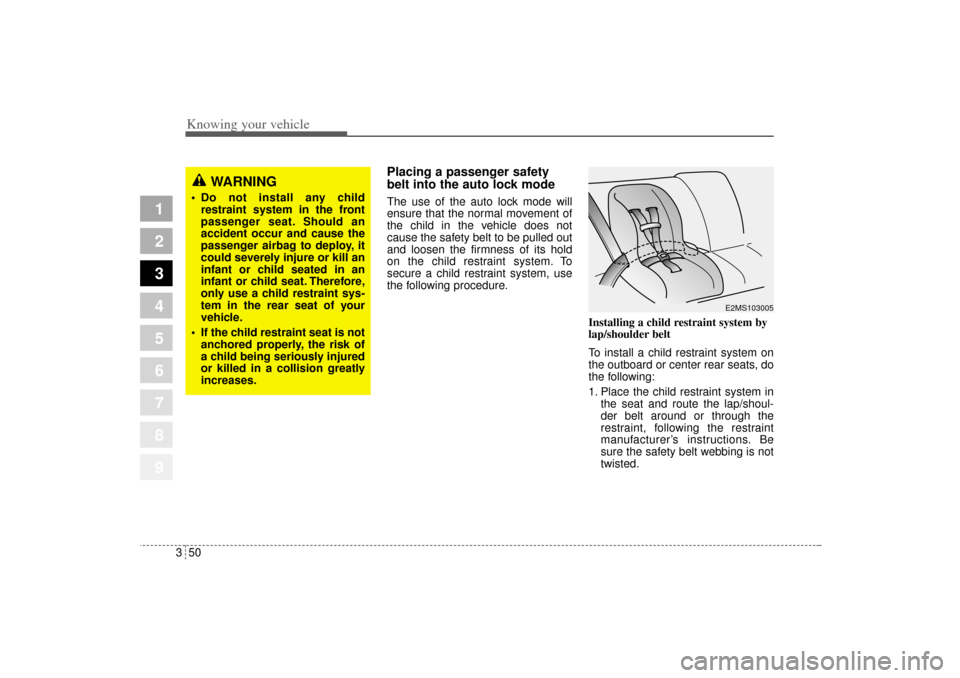
Knowing your vehicle50 3
1
2
3
4
5
6
7
8
9
Placing a passenger safety
belt into the auto lock modeThe use of the auto lock mode will
ensure that the normal movement of
the child in the vehicle does not
cause the safety belt to be pulled out
and loosen the firmness of its hold
on the child restraint system. To
secure a child restraint system, use
the following procedure.
Installing a child restraint system by
lap/shoulder belt
To install a child restraint system on
the outboard or center rear seats, do
the following:
1. Place the child restraint system in
the seat and route the lap/shoul-
der belt around or through the
restraint, following the restraint
manufacturer’s instructions. Be
sure the safety belt webbing is not
twisted.
WARNING
Do not install any child
restraint system in the front
passenger seat. Should an
accident occur and cause the
passenger airbag to deploy, it
could severely injure or kill an
infant or child seated in an
infant or child seat. Therefore,
only use a child restraint sys-
tem in the rear seat of your
vehicle.
If the child restraint seat is not
anchored properly, the risk of
a child being seriously injured
or killed in a collision greatly
increases.
E2MS103005
KM CAN (ENG) 3 (~57).qxd 9/13/2004 4:49 PM Page 50
Page 68 of 354
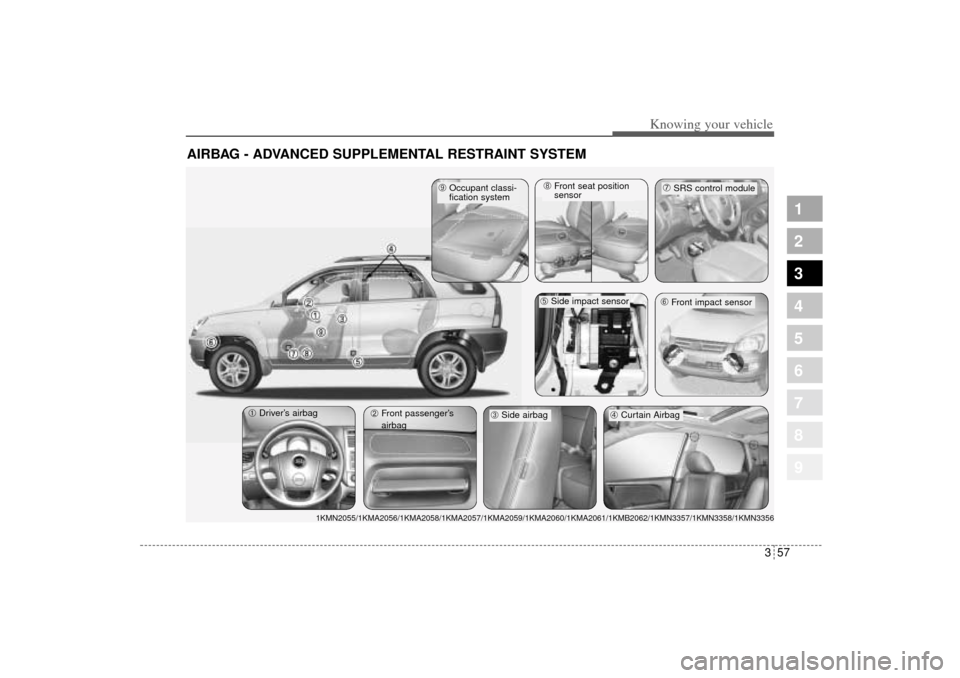
357
Knowing your vehicle
1
2
3
4
5
6
7
8
9
AIRBAG - ADVANCED SUPPLEMENTAL RESTRAINT SYSTEM
➀Driver’s airbag
➁Front passenger’s
airbag
➃Curtain Airbag
➅Front impact sensor➆SRS control module
1KMN2055/1KMA2056/1KMA2058/1KMA2057/1KMA2059/1KMA2060/1KMA2061/1KMB2062/1KMN3357/1KMN3358/1KMN3356
➂Side airbag
➄Side impact sensor
➈Occupant classi-
fication system
➇Front seat position
sensor
KM CAN (ENG) 3 (~57).qxd 9/13/2004 4:50 PM Page 57
Page 69 of 354
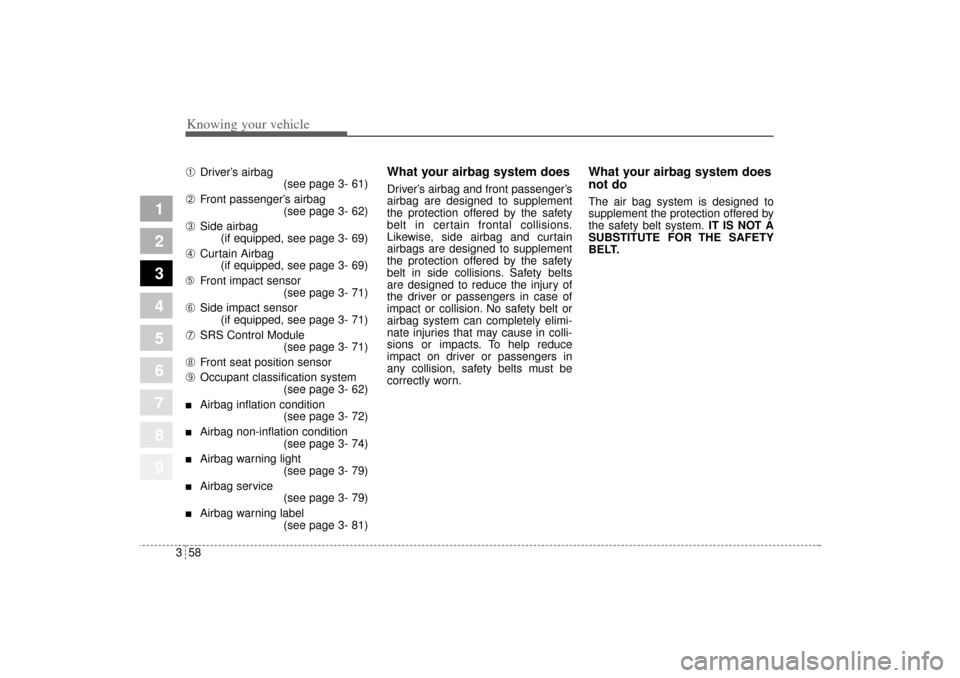
Knowing your vehicle58 3
1
2
3
4
5
6
7
8
9
➀
Driver’s airbag
(see page 3- 61)
➁
Front passenger’s airbag
(see page 3- 62)
➂
Side airbag
(if equipped, see page 3- 69)
➃
Curtain Airbag
(if equipped, see page 3- 69)
➄Front impact sensor
(see page 3- 71)
➅
Side impact sensor
(if equipped, see page 3- 71)
➆
SRS Control Module
(see page 3- 71)
➇
Front seat position sensor
➈
Occupant classification system
(see page 3- 62)
Airbag inflation condition
(see page 3- 72)
Airbag non-inflation condition
(see page 3- 74)
Airbag warning light
(see page 3- 79)
Airbag service
(see page 3- 79)
Airbag warning label
(see page 3- 81)
What your airbag system doesDriver’s airbag and front passenger’s
airbag are designed to supplement
the protection offered by the safety
belt in certain frontal collisions.
Likewise, side airbag and curtain
airbags are designed to supplement
the protection offered by the safety
belt in side collisions. Safety belts
are designed to reduce the injury of
the driver or passengers in case of
impact or collision. No safety belt or
airbag system can completely elimi-
nate injuries that may cause in colli-
sions or impacts. To help reduce
impact on driver or passengers in
any collision, safety belts must be
correctly worn.
What your airbag system does
not doThe air bag system is designed to
supplement the protection offered by
the safety belt system.IT IS NOT A
SUBSTITUTE FOR THE SAFETY
BELT.
KM CAN (ENG) 3 (~112).qxd 9/13/2004 4:50 PM Page 58
Page 70 of 354
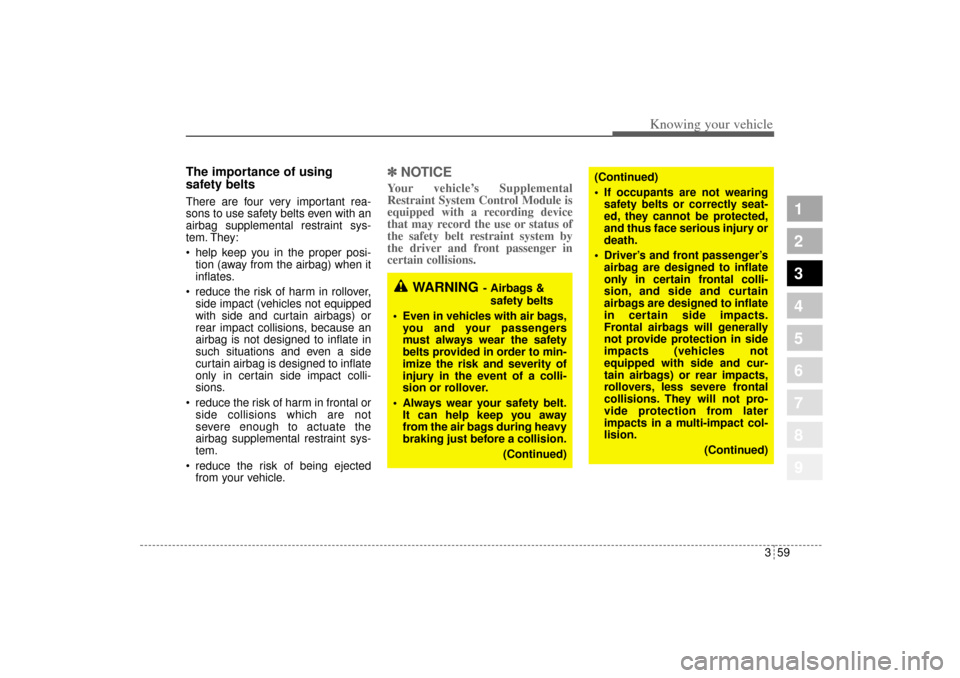
359
1
2
3
4
5
6
7
8
9
Knowing your vehicle
The importance of using
safety beltsThere are four very important rea-
sons to use safety belts even with an
airbag supplemental restraint sys-
tem. They:
help keep you in the proper posi-
tion (away from the airbag) when it
inflates.
reduce the risk of harm in rollover,
side impact (vehicles not equipped
with side and curtain airbags) or
rear impact collisions, because an
airbag is not designed to inflate in
such situations and even a side
curtain airbag is designed to inflate
only in certain side impact colli-
sions.
reduce the risk of harm in frontal or
side collisions which are not
severe enough to actuate the
airbag supplemental restraint sys-
tem.
reduce the risk of being ejected
from your vehicle.
✽ ✽
NOTICEYour vehicle’s Supplemental
Restraint System Control Module is
equipped with a recording device
that may record the use or status of
the safety belt restraint system by
the driver and front passenger in
certain collisions.
WARNING
- Airbags &
safety belts
• Even in vehicles with air bags,
you and your passengers
must always wear the safety
belts provided in order to min-
imize the risk and severity of
injury in the event of a colli-
sion or rollover.
Always wear your safety belt.
It can help keep you away
from the air bags during heavy
braking just before a collision.
(Continued)
(Continued)
If occupants are not wearing
safety belts or correctly seat-
ed, they cannot be protected,
and thus face serious injury or
death.
Driver’s and front passenger’s
airbag are designed to inflate
only in certain frontal colli-
sion, and side and curtain
airbags are designed to inflate
in certain side impacts.
Frontal airbags will generally
not provide protection in side
impacts (vehicles not
equipped with side and cur-
tain airbags) or rear impacts,
rollovers, less severe frontal
collisions. They will not pro-
vide protection from later
impacts in a multi-impact col-
lision.
(Continued)
KM CAN (ENG) 3 (~112).qxd 9/13/2004 4:50 PM Page 59
Page 71 of 354
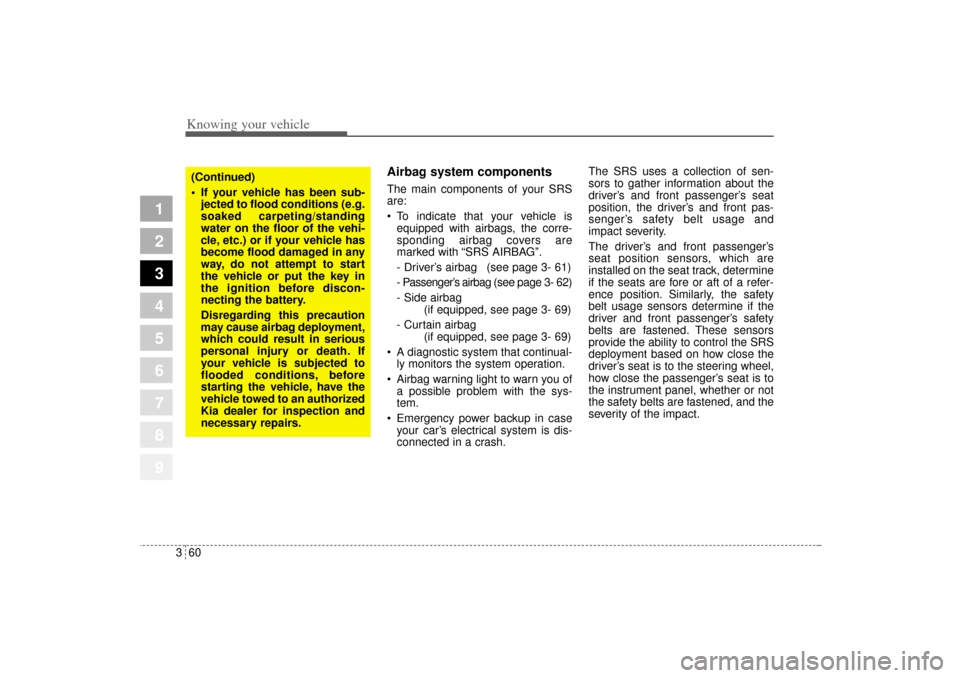
Knowing your vehicle60 3
1
2
3
4
5
6
7
8
9
Airbag system components The main components of your SRS
are:
To indicate that your vehicle is
equipped with airbags, the corre-
sponding airbag covers are
marked with “SRS AIRBAG”.
- Driver’s airbag (see page 3- 61)
- Passenger’s airbag(see page 3- 62)
- Side airbag
(if equipped, see page 3- 69)
- Curtain airbag
(if equipped, see page 3- 69)
A diagnostic system that continual-
ly monitors the system operation.
Airbag warning light to warn you of
a possible problem with the sys-
tem.
Emergency power backup in case
your car’s electrical system is dis-
connected in a crash.The SRS uses a collection of sen-
sors to gather information about the
driver’s and front passenger’s seat
position, the driver’s and front pas-
senger’s safety belt usage and
impact severity.
The driver’s and front passenger’s
seat position sensors, which are
installed on the seat track, determine
if the seats are fore or aft of a refer-
ence position. Similarly, the safety
belt usage sensors determine if the
driver and front passenger’s safety
belts are fastened. These sensors
provide the ability to control the SRS
deployment based on how close the
driver’s seat is to the steering wheel,
how close the passenger’s seat is to
the instrument panel, whether or not
the safety belts are fastened, and the
severity of the impact.
(Continued)
If your vehicle has been sub-
jected to flood conditions (e.g.
soaked carpeting/standing
water on the floor of the vehi-
cle, etc.) or if your vehicle has
become flood damaged in any
way, do not attempt to start
the vehicle or put the key in
the ignition before discon-
necting the battery.
Disregarding this precaution
may cause airbag deployment,
which could result in serious
personal injury or death. If
your vehicle is subjected to
flooded conditions, before
starting the vehicle, have the
vehicle towed to an authorized
Kia dealer for inspection and
necessary repairs.
KM CAN (ENG) 3 (~112).qxd 9/13/2004 4:50 PM Page 60
Page 72 of 354
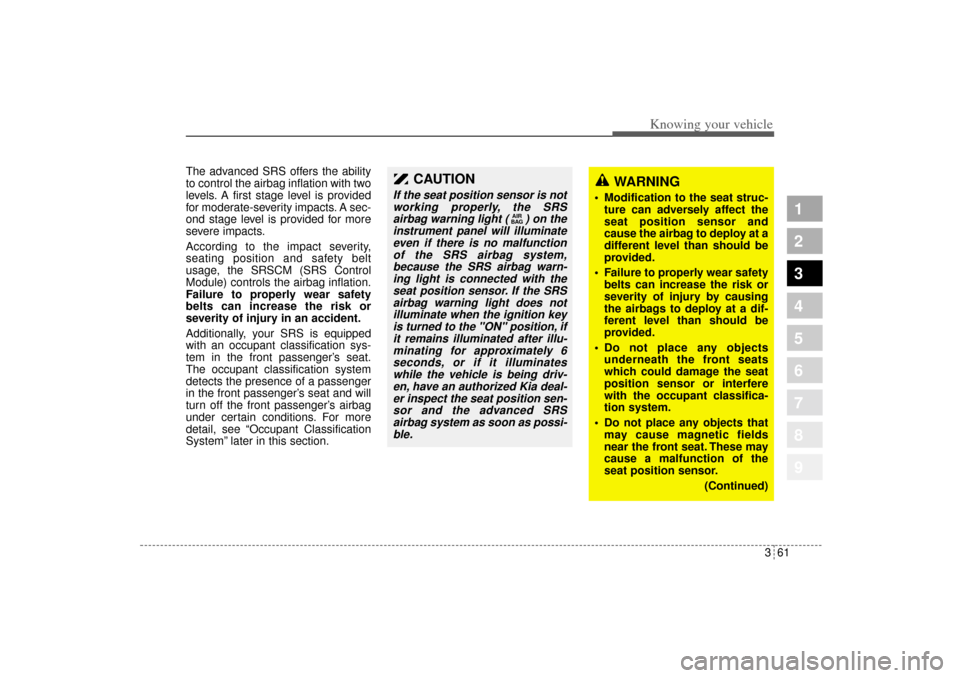
361
1
2
3
4
5
6
7
8
9
Knowing your vehicle
The advanced SRS offers the ability
to control the airbag inflation with two
levels. A first stage level is provided
for moderate-severity impacts. A sec-
ond stage level is provided for more
severe impacts.
According to the impact severity,
seating position and safety belt
usage, the SRSCM (SRS Control
Module) controls the airbag inflation.
Failure to properly wear safety
belts can increase the risk or
severity of injury in an accident.
Additionally, your SRS is equipped
with an occupant classification sys-
tem in the front passenger’s seat.
The occupant classification system
detects the presence of a passenger
in the front passenger’s seat and will
turn off the front passenger’s airbag
under certain conditions. For more
detail, see “Occupant Classification
System” later in this section.
CAUTION
If the seat position sensor is not
working properly, the SRS
airbag warning light ( ) on the
instrument panel will illuminate
even if there is no malfunction
of the SRS airbag system,
because the SRS airbag warn-
ing light is connected with the
seat position sensor. If the SRS
airbag warning light does not
illuminate when the ignition key
is turned to the "ON" position, if
it remains illuminated after illu-
minating for approximately 6
seconds, or if it illuminates
while the vehicle is being driv-
en, have an authorized Kia deal-
er inspect the seat position sen-
sor and the advanced SRS
airbag system as soon as possi-
ble.
AIR
BAG
WARNING
Modification to the seat struc-
ture can adversely affect the
seat position sensor and
cause the airbag to deploy at a
different level than should be
provided.
Failure to properly wear safety
belts can increase the risk or
severity of injury by causing
the airbags to deploy at a dif-
ferent level than should be
provided.
Do not place any objects
underneath the front seats
which could damage the seat
position sensor or interfere
with the occupant classifica-
tion system.
Do not place any objects that
may cause magnetic fields
near the front seat. These may
cause a malfunction of the
seat position sensor.
(Continued)
KM CAN (ENG) 3 (~112).qxd 9/13/2004 4:50 PM Page 61
Page 73 of 354
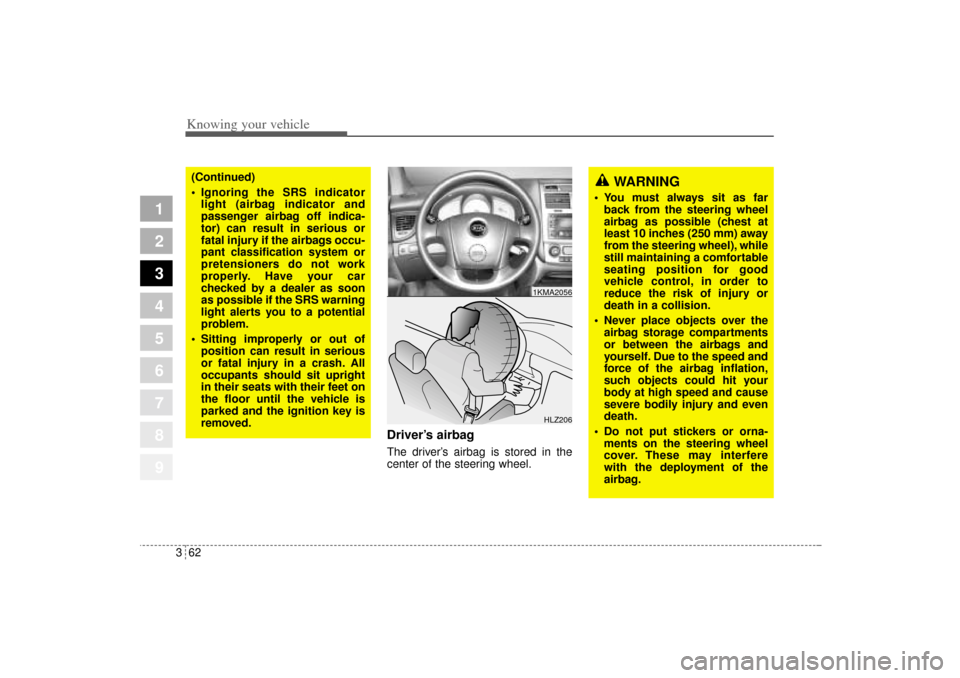
Knowing your vehicle62 3
1
2
3
4
5
6
7
8
9
Driver’s airbagThe driver’s airbag is stored in the
center of the steering wheel.
(Continued)
Ignoring the SRS indicator
light (airbag indicator and
passenger airbag off indica-
tor) can result in serious or
fatal injury if the airbags occu-
pant classification system or
pretensioners do not work
properly. Have your car
checked by a dealer as soon
as possible if the SRS warning
light alerts you to a potential
problem.
Sitting improperly or out of
position can result in serious
or fatal injury in a crash. All
occupants should sit upright
in their seats with their feet on
the floor until the vehicle is
parked and the ignition key is
removed.
WARNING
You must always sit as far
back from the steering wheel
airbag as possible (chest at
least 10 inches (250 mm) away
from the steering wheel), while
still maintaining a comfortable
seating position for good
vehicle control, in order to
reduce the risk of injury or
death in a collision.
Never place objects over the
airbag storage compartments
or between the airbags and
yourself. Due to the speed and
force of the airbag inflation,
such objects could hit your
body at high speed and cause
severe bodily injury and even
death.
Do not put stickers or orna-
ments on the steering wheel
cover. These may interfere
with the deployment of the
airbag.
HLZ2061KMA2056
KM CAN (ENG) 3 (~112).qxd 9/13/2004 4:50 PM Page 62
Page 74 of 354
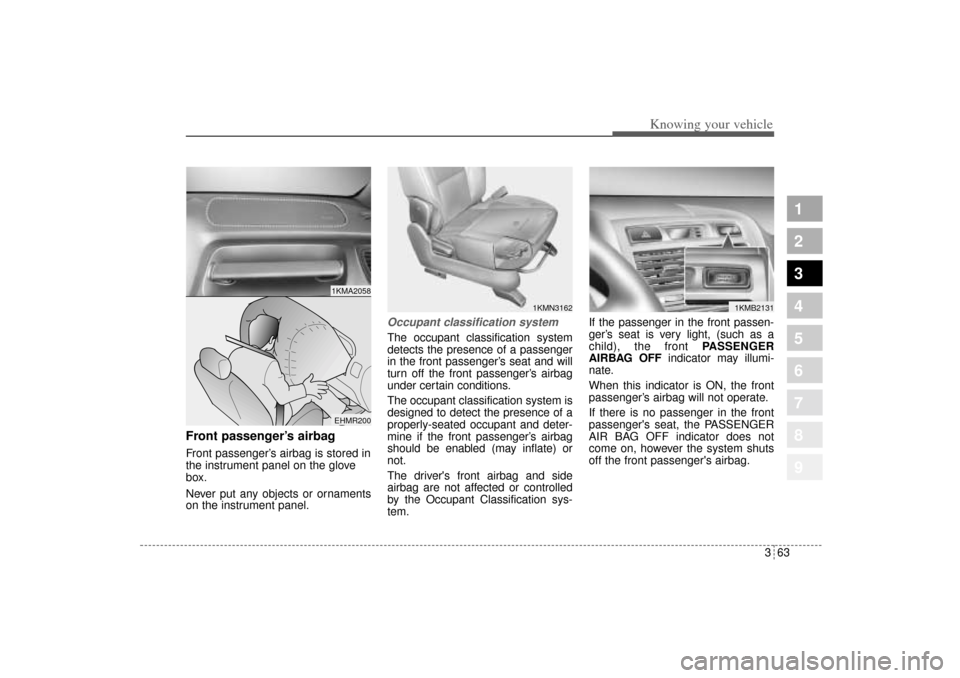
363
1
2
3
4
5
6
7
8
9
Knowing your vehicle
Front passenger’s airbagFront passenger’s airbag is stored in
the instrument panel on the glove
box.
Never put any objects or ornaments
on the instrument panel.
Occupant classification systemThe occupant classification system
detects the presence of a passenger
in the front passenger’s seat and will
turn off the front passenger’s airbag
under certain conditions.
The occupant classification system is
designed to detect the presence of a
properly-seated occupant and deter-
mine if the front passenger’s airbag
should be enabled (may inflate) or
not.
The driver's front airbag and side
airbag are not affected or controlled
by the Occupant Classification sys-
tem.If the passenger in the front passen-
ger’s seat is very light, (such as a
child), the front PASSENGER
AIRBAG OFFindicator may illumi-
nate.
When this indicator is ON, the front
passenger’s airbag will not operate.
If there is no passenger in the front
passenger's seat, the PASSENGER
AIR BAG OFF indicator does not
come on, however the system shuts
off the front passenger's airbag.
1KMB2131
1KMN3162
1KMA2058EHMR200
KM CAN (ENG) 3 (~112).qxd 9/13/2004 4:50 PM Page 63